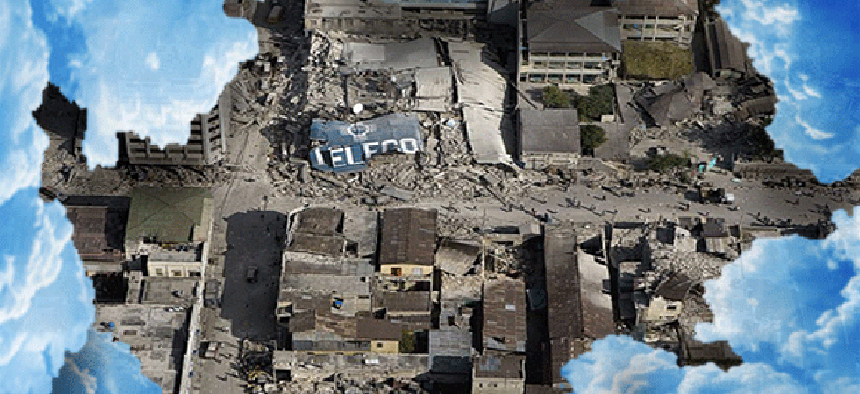NGA, geospatial community plan a clear picture of major disasters


Connecting state and local government leaders
A global consortium builds a cloud infrastructure to demonstrate how multinational organizations can share geospatial information after major disasters such as the 2010 Haiti earthquake.
UPDATE: This article has been corrected to reflect that Boeing's geo services includes software developed by OpenGeo, not by Boeing.
A major disaster, such as the 2010 earthquake in Haiti, typically draws help from a diverse array of international players, including emergency response crews, military units, non-governmental organizations, relief workers, physicians and a host of others who need an accurate view of the situation -- what infrastructure has been damaged and what’s still working.
But too often they work with different geospatial or mapping systems, impeding the sharing of information. In the aftermath of the Haiti earthquake, during which major landmarks were destroyed, emergency response workers even had to resort to creating paper-based maps, experts said.
A global consortium is working to solve that problem, creating a cloud infrastructure to demonstrate how a coalition of organizations can share geospatial information as they respond to such disasters. The concept was proposed by the National Geospatial-Intelligence Agency, which will provide unclassified data that supports a scenario depicting the Haiti earthquake.
NGA officials want to see how industry can deliver open standards-based geospatial data to first responders via multiple, interoperable cloud infrastructures, said Todd Myers, NGA’s lead global compute architect.
The Network Centric Operations Industry Consortium has awarded $350,000 to a team led by technology services provider NJVC to complete the first cycle of the project, which involved developing the cloud infrastructure.
NCOIC conducted a series of successful lab interoperability demonstrations, also based on Haiti, four times during 2010, focusing on the commercial cloud as a data-transport vehicle, said Tip Slater, NCOIC director of business development. This time around, the demonstration will center on multiple clouds, expanding the population of users who can post eyewitness views of what’s happening where they are, Slater noted.
NJVC’s Cloudcuity Management Portal, a multi-cloud broker service for the federal government, provides the underlying cloud infrastructure. Cloudcuity lets agencies try, design and price an array of services from cloud providers such as Amazon, Savvis and Terremark before committing to large-scale migration.
“Cycle one was all about exploring if this infrastructure could be built in a reasonable amount of time and provided within a cost and management model that could be deployed,” said Kevin Jackson, NJVC’s vice president and general manager of cloud services.
Other team members include Boeing, which provides geo services through OpenGeo’s software suite along with some Google geospatial capabilities; Aerospace Corp, which provides an OpenStack-based cloud and a virtual organization management system; and the Open Geospatial Consortium, which is monitoring and offering advice on the use of OGC-based standards during the demonstration.
Aerospace’s role is important because virtual organization technology is needed to manage groups of teams that are leveraging the cloud infrastructure and the data that is being used, and because of its use of OpenStack, Jackson said.
“The OpenStack component was a request I provided to the NCOIC participants,” said NGA’s Myers. NGA wanted OpenStack in the design pattern to ensure all geospatial data would be stored in the object-based storage environment so that everything can be consumed as a standard Open Geospatial Consortium service, he explained.
Some of the biggest interoperability challenges are the different data formats, system disparities and communication gaps in terms of semantics, said Roger Bernhardt, a business developer with Boeing’s Research and Technology Engineering Operations.
“What we are trying to do is assemble a demonstration that wraps services as data translators,” creating geospatial interoperability by translating to standards and data formats, Bernhardt said. “It is a small-scale effort at this time. We can’t claim to have solved the problem,” he said.
The first phase of the project, on a very rudimentary level, is a service architecture that supports a suite of data translators. Boeing has begun to wrap these data translators into its geospatial data servers. Theoretically, other geospatial servers added to the infrastructure can use the suite of translators, giving people the interoperability they seek, Bernhardt said.
This first phase of the project has been successfully completed. The second phase involves developing applications that will reside on the cloud infrastructure. NCOIC, a collaboration of leading aerospace, defense, information technology, large-scale integrator and services industries, has put out a call among members for the applications. Reponses to that request were due April 11.
During the second cycle, NCOIC members will plug into the cloud and use the geospatial data to activate unique, sometimes proprietary, applications that demonstrate end-user capabilities. An example could be rescue workers, firefighters, hospital personnel or even bankers trying to reconstitute a financial system, NCOIC officials said.
The demonstration will be conducted in July or August for NATO, NGA and other Defense Department agencies, Jackson said. The most likely deliverable from the exercise is a white paper that will describe how emergency response organizations can build a geospatial community cloud in a short period of time — renting the infrastructure when it’s needed and shutting it down afterwards.
“The [demonstration] infrastructure will be torn down, but essentially, it would be easy to bring it back together again,” Jackson said.




